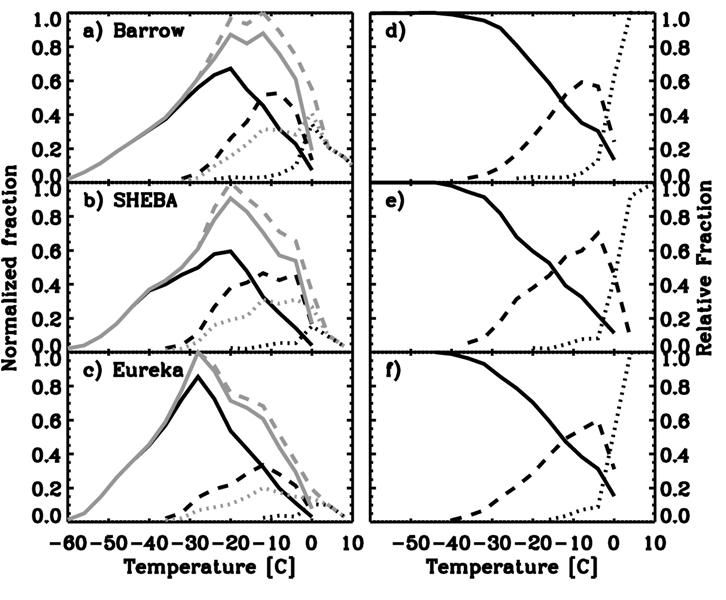Characterizing clouds at arctic atmospheric observatories
Submitter:
Shupe, Matthew — University of Colorado
Area of research:
Cloud Distributions/Characterizations
Journal Reference:
Science
Clouds play obvious and dominant roles in the Arctic atmospheric radiation and hydrologic cycles, thus imparting significant influence on surface temperatures, the mass balance of ice sheets, and the future status of Arctic sea ice. A better understanding of the important interactions and cloud feedbacks within the Arctic climate system requires a more detailed characterization of many first-order cloud properties, such as occurrence fraction, in addition to higher-order properties such as cloud phase, which largely determines cloud precipitation efficiency and radiative properties. Relative to other global locations, our understanding of Arctic clouds has been impeded by a paucity of comprehensive observations due to limited basic research infrastructure and the harsh Arctic environment.
To address this issue, a collaborative group of Arctic research scientists has assembled the limited cloud observations made over the past decade at six Arctic atmospheric observatories in order to investigate many basic cloud characteristics, including occurrence fraction, vertical distribution, persistence in time, diurnal cycle, boundary statistics, and phase distributions. Observatories in Barrow and Atqasuk (Alaska), Eureka (Canada), NyAlesund (Norway), Summit (Greenland), and the Beaufort Sea provide important perspectives on cloudiness in a variety of distinctive Arctic environments. Each of these international and multi-agency observatories supports some combination of ground-based cloud lidar, radar, ceilometer, interferometer, microwave radiometer, and/or radiosondes for identifying and characterizing clouds.
Impact
The assembled observations offer exciting new insights into Arctic cloudiness that move well beyond climatologies of the past, which have relied on subjective surface observations or imperfect satellite retrievals. These continuous ground-based observations reveal annual cloud occurrence fractions ranging from 58 to 83% among the observatories, with clear annual cycle variability wherein clouds are least frequent in winter and most frequent in late summer and fall. Only in Eureka is the annual cycle shifted such that the annual minimum is in spring with the maximum in winter.
Importantly, this study has also provided a broader examination of Arctic cloud phase. Generally, ice clouds are more prevalent than mixed-phase clouds, which are themselves more prevalent than liquid-only clouds. Regardless of cloud type, cloud ice occurs 60–70% of the time over a typical year at heights up to 11 km. Cloud liquid water occurs at temperatures above -40 degrees C and is increasingly more likely as temperatures increase. In the extreme cold temperature range of -40 to -30 degrees C, liquid water occurs in 3–5% of the observed cloudiness. Liquid water is found higher in the atmosphere when accompanied by ice; there are few liquid-only clouds above 3 km, although liquid in mixed-phase clouds occurs at heights up to about 7–8 km. Regardless of temperature or height, cloud liquid water occurs 56% of the time at Barrow and over the Beaufort Sea, but only 32% of the time at Eureka.
Monthly average total cloudiness at individual locations is typically within 10–15% of the all-site, Arctic-wide average. Interannual variability at specific sites is <13% for any given month and <3% for annual total cloud fraction, demonstrating relative consistency year to year. Low-level clouds are significantly longer-lived than cloudiness at other heights, leading to a near-surface maximum in cloud occurrence fraction (see Figure 1). The median cloud persistence for all observatories is 3–5 hours; however, 5% of cloud systems at Barrow and over the Beaufort Sea occur for longer than 100 consecutive hours. The most persistent liquid clouds, such as frequent stratocumulus, occur continuously for >3 days in the fall and often >1 full day even in the cold and dark winter.
Summary
Normalized cloud phase distributions as a function of atmospheric temperature (e.g., Figure 1) and relative humidity are very similar at all of the sites where phase classification is possible. However, significant inter-site differences do occur in both the frequency of occurrence for clouds of different phases and their annual variability. These results suggest that the processes responsible for cloud formation and phase determination are similar across the Arctic, while it is the larger-scale meteorology that determines the actual distribution of clouds and cloud phase at a specific location. For example, the lower atmosphere is generally moister and warmer at Barrow compared to Eureka, resulting in much more frequent liquid water clouds at the former site relative to the later. These spatial differences in meteorology, and their subsequent impact on cloud characteristics, will be important to both better understand and simulate in numerical models in order to more accurately predict future trends in Arctic climate.


